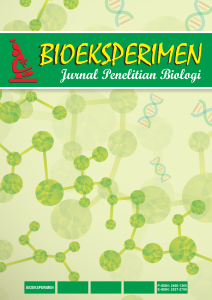Analysis Of Ichthyofauna Of Situ Bagendit and Water Quality Post-Revitalization
Water quality data, Fish Diversity and Abundance Data
DOI:
https://doi.org/10.23917/bioeksperimen.v11i1.10057Keywords:
fish diversity, water quality, Situ Bagendit, revitalization, bioindicatorsAbstract
Situ Bagendit is one of the natural lakes in Garut Regency that has experienced a decline in environmental quality, so revitalization was carried out to improve the ecosystem and increase tourist attractions. Sampling at three observation stations based on water characteristics. The parameters observed include biotic factors (fish diversity) and abiotic factors (physical and chemical parameters of water. The Shannon-Wiener diversity index is used to assess the stability of the fish community, while water quality is analyzed based on water quality standards according to PP No. 22 of 2021 and lake trophic classification. The results of the study showed that water quality data that did not meet the threshold according to PP No. 21 of 2021 were water clarity (75-136 cm), chemical oxygen demand (COD) (21-31 mg/L), total nitrogen (1.22-1.59) and conductivity (506-588 μs/cm). Fish diversity is at a moderate level with an index of 1.22. The abundance value ranges from 4-55% with the highest abundance value being the hemichromis elongatus species (zebra tilapia), but there is no dominant species. A fish species found as an indicator of pollution is the janitor fish (pterygoplichthys pardalis) due to its high adaptability to polluted water. While several water quality parameters have not fully met class II quality standards, especially in terms of brightness, COD, total nitrogen, and conductivity. Ecosystem conditions of Situ Bagendit still requires sustainable management to maintain water quality and biodiversity.
Downloads
References
Amelia, R., Marsi., & Ferdinand, H. T. (2012). Survival, Growth and Oxygen Consumption Level of Catfish (pangius sp.) Exposed to Palm Oil Mill Liquid Waste. Indonesian Swamp Aquaculture Journal, 1(2): 203-215.
Amelia, R., Marsi, & Ferdinand, H. T. (2012). Survival, growth and oxygen consumption level of catfish (Pangasius sp.) exposed to palm oil mill liquid waste. Indonesian Swamp Aquaculture Journal, 1(2), 203–215.
Amornsakun, T., Sriwatana, W., & Promkaew, P. (2005). Survival and growth rate of striped snakehead fish (Channa striata) larvae under different oxygen conditions. Songklanakarin Journal of Science and Technology, 27(4), 815–822.
Andara, D. R., Haeruddin, & Suryanto, A. (2014). Total suspended solids content, biochemical oxygen demand and chemical oxygen demand and pollution index of Klampisan River in Candi Industrial Area, Semarang. Management of Aquatic Resources Journal (MAQUARES), 3(3), 177–187. https://doi.org/10.14710/marj.v3i3.6709
Arlindia, I. (2015). Analysis of Lake Maninjau pollution from TDS values and electrical conductivity. Unand Physics Journal, 4(4).
Authman, M. M. N., Zaki, M. S., Khallaf, E. A., & Abbas, H. H. (2015). Use of fish as bio-indicator of the effects of heavy metals pollution. Environmental Monitoring and Assessment, 187(499), 1–20. https://doi.org/10.1007/s10661-015-4671-6
Courtenay, W. R., & Williams, J. D. (2004). Snakeheads (Pisces, Channidae)—A biological synopsis and risk assessment. U.S. Geological Survey Circular, 1251, 1–143.
Haribowo, D. R., et al. (2023). Phytoplankton community as a bioindicator of water quality in East Ciputat, South Tangerang. Journal of Biology Science & Education, 12(2), July–December. ISSN 2252-858X / e-ISSN 2541-1225.
Hertika, A. M. S., Arsad, S., & Putra, R. B. D. (2022). Science of plankton and its role in aquatic environment. UB Press.
Hertika, A. M. S., Putra, R. B. D. S., & Arsad, S. (2022). Water quality and its management. Malang: Universitas Brawijaya Press.
Hutagalung, R. A., & Putri, H. K. (2022). Monosex tilapia fish cultivation technique (Oreochromis niloticus) as an alternative in increasing fish cultivation productivity in floating net cages in Buntut Limbung Hamlet, Muara Baru Village, Sungai Raya District, Raya Regency. Kapuas Journal, 2(1), 12–19. https://ejurnal.polnep.ac.id/index.php/JK/article/view/362
Ismail, A., & Yusof, S. (2011). Effect of mercury and cadmium on early life stages of Java medaka (Oryzias javanicus): A potential tropical test fish. Marine Pollution Bulletin, 63(5–12), 347–349.
Kartamihardja, E. S., & Satria, F. (2000). Fish communities and inland aquatic ecosystems. Jakarta: Center for Fisheries Research and Development, Agricultural Research and Development Agency, Ministry of Agriculture.
Kementerian Pekerjaan Umum dan Perumahan Rakyat. (2022, June 2). Kementerian PUPR completes revitalization of Situ Bagendit, a new tourism icon in Garut. Retrieved from: https://pu.go.id/berita/kementerian-pupr-selesaikan-revitalisasi-situ-bagendit-ikon-pariwisata-baru-di-garut
Kottelat, M., & Whitten, A. J. (2009). Freshwater fishes of Western Indonesia and Sulawesi: Additions and corrections. Singapore: Periplus Editions.
Kullander, S. O. (2003). Cichlidae (Cichlids). In R. E. Reis, S. O. Kullander, & C. J. Ferraris Jr. (Eds.), Checklist of the freshwater fishes of South and Central America (pp. 605–654). Porto Alegre: EDIPUCRS.
Kurniawan, S. R. (2019). Eutrophication level of Situ Bagendit based on plankton data [S1 thesis, Indonesian Education University].
Lembaga Ilmu Pengetahuan Indonesia. (2020, December 3). LIPI identifies 5,807 lakes across Indonesia. ANTARA News. Retrieved from https://www.antaranews.com/berita/1874548/lipi-identifikasi-ada-5807-danau-di-indonesia
Munni, M., Momota, M., Rahman, M., & Alam, M. (2015). Assessment of fish diversity and water quality parameters of Balu River. Global Journal of Animal Scientific Research, 3(1), 220–229.
Nontji, A. (2006). There is no life on earth without the existence of plankton. Indonesian Institute of Sciences – Oceanography Research Center.
Nugroho, R. A., & Santoso, B. (2014). Daily activities of fish in relation to feeding behavior and optimal fishing time. Journal of Fisheries and Marine Affairs, 5(2), 123–130.
Nurfiarini, A., & Purnomo, P. (2009). Diversity of fish species in Situ Bagendit, Garut Regency. Journal of Fisheries and Marine, 4(1), 45–52.
Putri, A. Y., et al. (2020). The effect of aquatic plants on nitrogen content in water. Journal of Environmental Studies, 9(1), 67–74. (Judul jurnal disesuaikan dengan isi artikel; tidak ada informasi lengkap dalam naskah asli.
Saanin, H. (1984). Taxonomy and fish identification keys I and II. Bogor: Bina Cipta.
Samuel, M., & Makmur, S. (2012). Aquatic plants as fish shelters: Ecological functions and importance in lake ecosystems. Journal of Aquatic Ecology, 8(2), 101–108.
Sihombing, D. (2011). The effect of water turbidity on the quality of aquatic environments. Journal of Aquatic Ecology, 7(1), 42–50.
Sow, A. Y., Ismail, A., & Zulkifli, S. Z. (2012). Copper and zinc speciation in soils from paddy cultivation areas in Kelantan, Malaysia. Acta Biologica Malaysiana, 1(1), 26–35.
Sukmawati, L. (2013). The effect of water hyacinth on water shallowing. Journal of Aquatic Ecosystems, 6(2), 85–93.
Surtikanti, H. K. (2014). The charm of Indonesian water bodies. Bandung: Rizqi Press.
Tjakrawidjaja, A. H., Zoology, H. B., & Haryono, Biology-LIPI, P. (2001). Study of Kaloso fish (Scleropages jardinii) population in Rawa Pomo, Citak Mitak District, Merauke Regency, Papua. Berita Biologi, 5(1), 11–17.
Tucker, C. S., & Hargreaves, J. A. (2004). Biology and culture of tilapias. In C. S. Tucker & J. A. Hargreaves (Eds.), Biology and culture of channel catfish (pp. 397–455). Elsevier.
Downloads
Submitted
Accepted
Published
Issue
Section
License
Copyright (c) 2025 Bioeksperimen: Jurnal Penelitian Biologi

This work is licensed under a Creative Commons Attribution-NonCommercial 4.0 International License.












